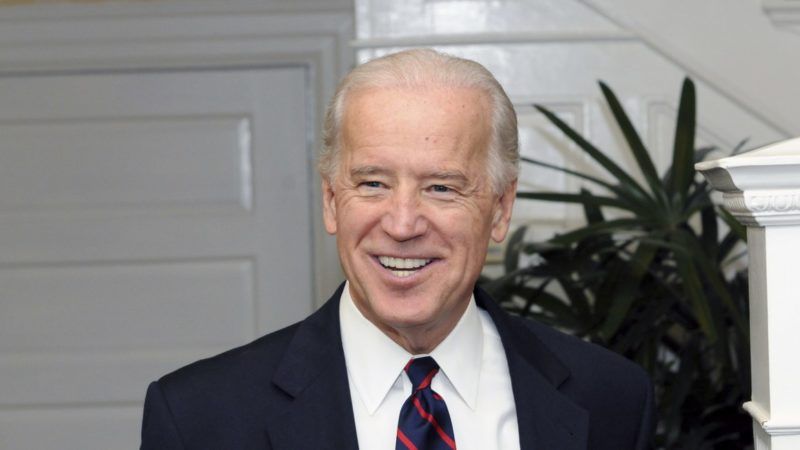Biden Says High-Speed Rail Will Get Millions of Cars Off the Road. That's Malarkey.
This is what happens when you think all of America looks like the Acela corridor.

In the midst of Sunday's presidential debate between Joe Biden and Bernie Sanders, Biden blurted out that his campaign's high-speed rail plan would take "millions of automobiles off the road."
This is the second debate in which the former vice president brought up the belief that bullet trains will get people out of their cars. This is, to put it mildly, extremely unlikely.
Biden's campaign site calls for "the construction of an end-to-end high speed rail system that will connect the coasts, unlocking new, affordable access for every American." Would bullet trains passing through major cities scattered across the U.S. actually get people out of their cars?
"The answer is no," explains Baruch Feigenbaum, assistant director of transportation policy at the Reason Foundation. (Full disclosure: The Reason Foundation publishes this website.) "High-speed rail primarily takes customers from aviation. Car travel might be substitutable with inner city buses, but we don't really see it in rail. That's not why other countries have built high-speed rail."
Feigenbaum notes that countries that have built high-speed rail have typically done so to reduce crowding on existing rail lines, not as a substitute for roads. The sole exception was China, which used it as an economic development project during a time when its highway system was much less robust than America's.
"Basically, Biden loves rail," Feigenbaum says, noting the vice president's roots in the northeastern Acela corridor. Indeed, the first high-speed rail project Biden says he'll focus on is increasing the speed of trains traveling from New York City to D.C. That region is the only part of America where rail travel has been shown to be efficient and profitable. Taking that mentality and trying to stretch it across the U.S. is absurd.
And no, this travel will not be all that more "affordable" than air travel—not unless the trips themselves are heavily subsidized. High-speed rail does not help the poor access the job market better or travel more freely.
"High-speed rail benefits wealthy business travelers," Feigenbaum points out. "How this plan helps the Democratic base is unclear to me."
Perhaps because—as we've seen with California's efforts in this area—high-speed rail is more of a jobs program than a realistic plan to make mass transportation greener. When Feigenbaum critiqued Biden's infrastructure plan in December, he wasn't impressed with Biden's emphasis on feeding jobs to construction unions over actually fulfilling transportation needs:
We shouldn't build transportation projects to create a bunch of temporary jobs; we should invest in transportation to improve mobility and the economy, and then the robust economy creates jobs. Further, Biden's plan reads as though we are still in the throes of the Great Recession of a decade ago, not at the record-low unemployment we are now experiencing….
The plan assumes that investing in high-speed rail (HSR) and light rail would reduce greenhouse gas emissions. Yet, studies have shown that bus, not light rail, is more effective at reducing greenhouse gas emissions since most light rail vehicles have few riders outside of peak periods. High-speed rail is extremely energy-intensive to build. The California high-speed rail project would have needed to operate for 71 years at average capacity to neutralize the emissions needed to build the line. If Biden's goal is to reduce greenhouse gas emissions, there are much easier and cheaper ways to do so than building HSR and light rail.
The inclusion of light rail and HSR won't help working-class communities, either. Building light rail lines typically leads to gentrification, which increases home prices and forces low-income minorities to move. (The new residents use light rail less frequently than the displaced residents). HSR is frequented primarily by wealthy business travelers. Lower-income residents use intercity buses, which benefit from improved highway conditions, not rail upgrades.
Meanwhile, California's zombie bullet train project remains a shambling mess that refuses to die. Its estimated price tag increased to $80.3 billion in February. (California voters authorized the state to spend only $33 billion on it.) Earlier this month, the Los Angeles Times reported that managers who were working on the project were told to keep their mouths shut about any problems or face termination. Several have walked away from it, one calling it the "worst job of [his] career."
California's efforts should serve as a warning: Politicians and other self-serving interests will declare their pet projects "green" to attract huge chunks of money whether or not the projects actually help the environment. High-speed rail doesn't "get cars off the road," won't reduce congestion in cities, and won't make travel more "accessible" to the poor. But poor people's taxes will still be used to subsidize the travels of the business and leisure classes.